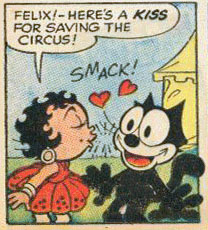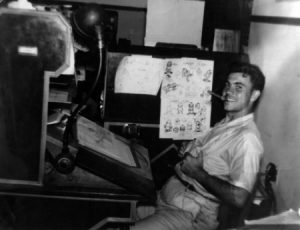
Today’s artist is more notable than many of the others profiled on this column — from animator to entrepreneur, here’s Joe Oriolo!
One of six children among an Italian immigrant family, Joe Oriolo was born in 1913 at Union City, New Jersey. He attended Union Hill High School and soon moved to New York City, where he enrolled at the Cooper Union for the Advancement of Science and Art. Oriolo’s first job in the art field was as a show card writer for Sears Roebuck.
He joined Max Fleischer’s studio as an errand boy in April 1933. Within a few years, he became an animator in Dave Tendlar’s unit; though he worked on such films as I Wanna Be a Lifeguard (1936) and A Car-Tune Portrait (1937), Oriolo didn’t gain screen credit until The Tears of an Onion (1938). He followed the studio along when it relocated to Miami in 1938, where he animated on their first feature film Gulliver’s Travels.
Oriolo continued to animate at the studio in Miami, after Paramount bought the studio and re-established the former Fleischer facility as Famous Studios in the early ‘40s. He served as head animator (de-facto director) on two Popeye cartoons released in 1943, A Jolly Good Furlough and The Hungry Goat, though Dan Gordon received the “director” credit. After leaving Famous Studios in 1944, he freelanced on animated industrial films, drew “funny animal” stories – for various publishers such as Sangor’s Cinema Comics outfit in New York, Hillman Periodicals and Fawcett – and established his own studio, Animated Teletoons, for early television commercials during this period.
He was involved with the Famous Studios cartoon The Friendly Ghost, released in 1945 – but only in its origins, a few years earlier. In 1939, Oriolo created the character of Casper the Friendly Ghost with Fleischer staffer Seymour Reit. Intended as a children’s book, the story went unpublished. He sold the rights to Paramount, and Famous adapted the story as Casper’s debut appearance. This sparked a rivalry between the authorship of the character, but the credit went to Bill Turner and Otto Messmer for “story adaptation.”
Today, Messmer is known as true creator of the popular Felix the Cat at Pat Sullivan’s studio throughout the 1920s. Oriolo’s relationship with Messmer began during Messmer’s brief period as a story artist at Famous. Besides working at Douglas Leigh Organization on their animated electric neon signs in Times Square, Messmer drew original Felix stories for Western Publishing, published by 1946. (Many of the previous Felix comics were reprints of earlier newspaper strips.) Messmer struggled to balance his full-time position at Douglas Leigh and drawing the Felix comics and daily strips, so he enlisted the help of Oriolo—and Jim Tyer—to assist him on the stories. After Tyer stopped drawing for them, Messmer and Oriolo often drew their own sections of different Felix stories; on occasion, Messmer penciled and lettered the stories, while Oriolo inked them.
 Around 1953, King Features Syndicate wanted to remove Messmer from the Felix comic strip and have Oriolo take over – but Oriolo refused. KFS let Messmer continue for another year, then retired him due to the strip’s lack of success. They insisted Oriolo continue the drawing duties. Soon after taking over the comics, he assumed legal ownership of the character, incorporating Felix the Cat Creations in 1958. He wanted to revive Felix in a television series, but he had to put up his own money to finance a pilot episode. Trans-Lux was interested in the show, and asked Oriolo to produce and direct 260 episodes.
Around 1953, King Features Syndicate wanted to remove Messmer from the Felix comic strip and have Oriolo take over – but Oriolo refused. KFS let Messmer continue for another year, then retired him due to the strip’s lack of success. They insisted Oriolo continue the drawing duties. Soon after taking over the comics, he assumed legal ownership of the character, incorporating Felix the Cat Creations in 1958. He wanted to revive Felix in a television series, but he had to put up his own money to finance a pilot episode. Trans-Lux was interested in the show, and asked Oriolo to produce and direct 260 episodes.
By 1960, a second television series with Felix, and several other pilots, were planned by Oriolo’s studio. Trans-Lux refused to accommodate the money to support it, and he was forced to disband. After his studio dissolved, he set up a studio called Adventure Cartoon Productions, where he produced and directed The Mighty Hercules (1963-66). Oriolo also licensed Japanese animated productions such as Osamu Tezuka’s Wonders 3 and Princess Knight for American TV (renaming them The Amazing 3 and Choppy and the Princess, respectively), and produced television commercials. Oriolo also acted as producer on the infamous Johnny Cypher in the Dimension Zero, which aired in late 1967. For this series, he outsourced the animation to Japan.
After Pat Sullivan’s nephew passed away in 1971, Felix the Cat Creations was dissolved and Oriolo became president of Felix the Cat Productions, Inc. A year later, he formed Oriolo Film Studios with his partner Bert Hecht. Their studio was given an option to produce the feature film, Raggedy Ann and Andy: A Musical Adventure. The project was ultimately taken over by Richard Williams. Oriolo produced another television show with Felix, which debuted in 1982 as a half-hour live-action series. Oriolo spent the remainder of his life overseeing Felix’s merchandising up until his death on Christmas Day, 1985.
His son, Don Oriolo, the musical director of the 1982 live-action show, took over the franchise, and continues to keep the character alive. His paintings of the “wonderful, wonderful cat” can be seen at this link.

• “Bernie the Fox”—Real Funnies #1 (January 1943).
• Punch and Judy #1 (undated, 1944).
• “Asteroid Adventure” (Rusty)—George Pal’s Puppetoons #14 (August 1947).
• Felix the Cat #40 (April 1953).
• “The Warm Heart” — Felix the Cat #49 (January 1954). [This particular holiday story isn’t available to me at the moment, but the original art in its entirety exists.]
• “The Big Finale” — Felix the Cat #70 (April 1956). [Thanks to Dave Gerstein for the scans!]
• “Giant Size” — Felix the Cat #74 (August 1956). [Like the January 1954 story, here is the original art of the entire story in its place. Dave Gerstein adds: “Tic, Tac and Toe, the Merry Midgets, were Messmer creations from the late 1930s, whom Oriolo reused into the late 1950s. It’s a little odd in that the characters are actually magical elves or dwarfs, so the name “midgets” is a bit odd to give them.”]

(Thanks to John Canemaker, Dave Gerstein and Yowp for their help.)




 DEVON BAXTER is a film restoration artist, video editor, and animation researcher/writer currently residing in Pennsylvania. He also hosts a
DEVON BAXTER is a film restoration artist, video editor, and animation researcher/writer currently residing in Pennsylvania. He also hosts a 



















































































Anyone else notice that Katrina in “The Big Finale” looks a lot like Betty Boop?
I noticed that right away. Well, Oriolo didn’t forget his roots.☺
Really great post, Devon!
Didn’t know that Joe did another Bernie the Fox story, but for “Real Funnies”.
I wonder if Bernie the Fox was based on Berny Wolf?
From what I can find, the “Felix the Cat” newspaper strip lasted until 1967. Did Joe Oriolo draw the strip until the end, even when he was producing the TV series? I assumed the heavy workload managing both the strip and the animation studio would force him to rely on assistants.
So that makes four important people in animation who died the same year I was born. (The others so far are Clarence Nash, Bill Scott, and one Hanna-Barbera animator whose name evades me.)
As I remember Choppy and the Princess was a full length feature film based on The Princess Knight television series. I remember seeing it on KTLA CH5 back in the 1970s ironically The Princess Knight to my knowledge wasn’t shown in the SoCal television market while other cities including Honolulu did show The Princess Knight. Several years later the LATAM Spanish dub of The Princess Knight aka La Princesa Caballero was shown on KMEX CH 34.
There was a “live-action” Felix the Cat show in the 80’s? What exactly do you mean by “live-action?” People in cat costumes? I’ve never heard of this!
Yep – people in costumes.
Keep it away from me!
Felix continued as a Joe Oriolo well thru 1961, using WInston Sharples stock cues from the latest Paramounts (all the Skit and Skat cartoons, latest being fall 1960 and the 1961 one shot Houndabout, revealing that the series continued thru 1961).
THe wonderful cat,:) BTWJohnny Nash got an early start doing the (credited vocal!) Hercules theme!